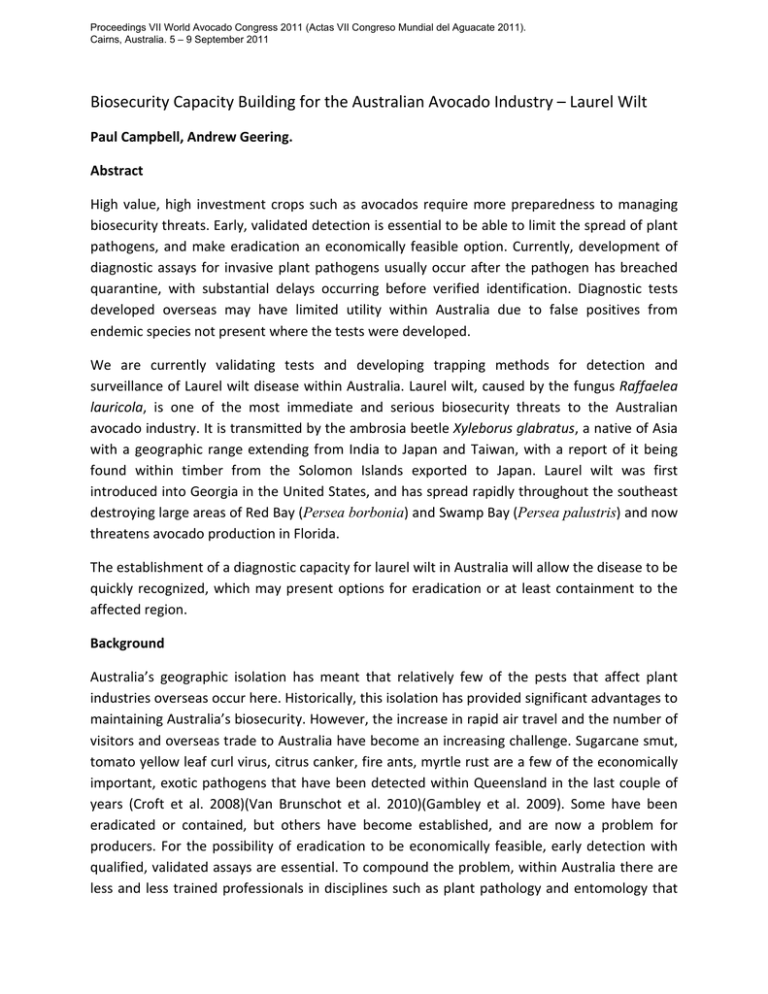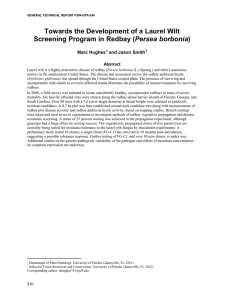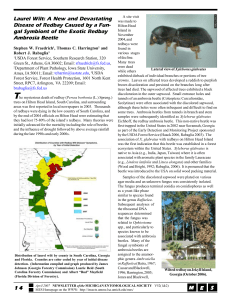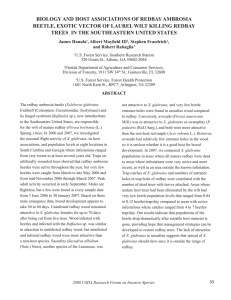Proceedings VII World Avocado Congress 2011 (Actas VII Congreso Mundial... Cairns, Australia. 5 – 9 September 2011
advertisement

Proceedings VII World Avocado Congress 2011 (Actas VII Congreso Mundial del Aguacate 2011). Cairns, Australia. 5 – 9 September 2011 Biosecurity Capacity Building for the Australian Avocado Industry – Laurel Wilt Paul Campbell, Andrew Geering. Abstract High value, high investment crops such as avocados require more preparedness to managing biosecurity threats. Early, validated detection is essential to be able to limit the spread of plant pathogens, and make eradication an economically feasible option. Currently, development of diagnostic assays for invasive plant pathogens usually occur after the pathogen has breached quarantine, with substantial delays occurring before verified identification. Diagnostic tests developed overseas may have limited utility within Australia due to false positives from endemic species not present where the tests were developed. We are currently validating tests and developing trapping methods for detection and surveillance of Laurel wilt disease within Australia. Laurel wilt, caused by the fungus Raffaelea lauricola, is one of the most immediate and serious biosecurity threats to the Australian avocado industry. It is transmitted by the ambrosia beetle Xyleborus glabratus, a native of Asia with a geographic range extending from India to Japan and Taiwan, with a report of it being found within timber from the Solomon Islands exported to Japan. Laurel wilt was first introduced into Georgia in the United States, and has spread rapidly throughout the southeast destroying large areas of Red Bay (Persea borbonia) and Swamp Bay (Persea palustris) and now threatens avocado production in Florida. The establishment of a diagnostic capacity for laurel wilt in Australia will allow the disease to be quickly recognized, which may present options for eradication or at least containment to the affected region. Background Australia’s geographic isolation has meant that relatively few of the pests that affect plant industries overseas occur here. Historically, this isolation has provided significant advantages to maintaining Australia’s biosecurity. However, the increase in rapid air travel and the number of visitors and overseas trade to Australia have become an increasing challenge. Sugarcane smut, tomato yellow leaf curl virus, citrus canker, fire ants, myrtle rust are a few of the economically important, exotic pathogens that have been detected within Queensland in the last couple of years (Croft et al. 2008)(Van Brunschot et al. 2010)(Gambley et al. 2009). Some have been eradicated or contained, but others have become established, and are now a problem for producers. For the possibility of eradication to be economically feasible, early detection with qualified, validated assays are essential. To compound the problem, within Australia there are less and less trained professionals in disciplines such as plant pathology and entomology that are able to conduct these tests. Molecular techniques are becoming the most common form of screening tests due to their rapidity, specificity, and that once developed and validated, only moderately skilled technicians are required to perform a diagnosis. A properly developed molecular test including proper controls has only a small chance of false negatives, but validation testing is required in the region that it will used in due to false positives. To minimise the chance of a false positive, the tests need to be validated against the endemic species of the area, which are most likely different if an overseas assay is used. In contrast to the medical and veterinary industries, there are a large number of plant pathogens, and limited money in diagnosis and treatment. Only a small number of plant pathogens are economically important enough to warrant complete, and validated diagnostic assay development. Diagnostic tests on biosecurity important pathogens which are properly developed pre-entry are usually on pathogens that that have the potential to devastate an industry were they to breach quarantine. Usually though, tests are developed for a pathogen once it is detected post entry, and the delay between first recognition and the development of an assay sufficiently to be able to routinely diagnose samples can be considerable. In the case of entry of exotic pathogens, a large number of samples have to be quickly tested to delimit the edges of the infected region, to establish movement barriers that will help to limit spread of the pathogen. The development of the Plant Biosecurity Toolbox (pbt.padil.gov.au) is an important step for diagnostics, especially considering the loss of critical skills throughout the plant pathology and entomology fields. The Plant Biosecurity Toolbox is an extension of the Pests and Diseases Image Library (PaDIL – www.padil.gov.au), a web-based resource with free access to highquality images, host and pest distribution information with coverage of invertebrates, bacteria, fungi, viruses, viroids and phytoplasmas that are pests and diseases of field crops, pasture, forestry, horticulture, marine, medical and veterinary fields. Both these sites were developed by the Cooperative Research Centre for National Plant Biosecurity (CRCNPB), and provides an easy to access, web-based diagnostic resources that are openly available. The goal is the collection of comprehensive diagnostic information for all plant pests of economic importance. The information contained in the toolbox ranges from basic biology of the organism to detailed molecular and taxonomic methodologies. The site is therefore useful for a broad range of people, from growers or consultants looking for disease symptoms or images of insect pests to help with identification, while molecular diagnosticians can find detailed protocols for definitive identification, and even regulators may wish to know about the biology and distribution of the pest to make informed policy decisions. The diagnostic protocols uploaded should be complete, validated to work in Australia, and contain details for obtaining positive control reagents. These protocols are developed and uploaded to the website by co-operating laboratories, usually funded by various industries. Laurel Wilt in Avocados Laurel wilt has the potential to decimate the Australian avocado industry. The causal agent is the fungus Raffalea lauricola. It is spread by an ambrosia beetle Xyleborus glabratus. R. lauricola is a wood decay fungus of plant species in the family Lauraceae (the avocado family) and has a symbiotic relationship with xylem-inhabiting ambrosia beetles, principally Xyleborus glabratus. Ambrosia beetles do not eat wood but instead use it to build galleries to brood their eggs. The fungus is introduced into the wood by the beetles and the beetle larvae feed off the fungal hyphae as it colonizes the wood. Female ambrosia beetles in this genus have specialized fungal spore-carrying sac called mycangia, which are located below the insect’s mandibles and it is in this way that trees are inoculated with the pathogen. Laurel wilt was first observed in the USA in redbay (Persea borbonia) a native Lauraceae species, in the low coastal plains of South Carolina, Georgia and northeastern Florida, in 200203 (Fraedrich et al. 2007). It is thought to have to have been introduced along with X. glabratus in wooden packing material (crates or pallets) used to transport commercial cargo (Haack 2006; Harmon and Brown 2009). X. glabratus is native to Asia and has been recorded in India, Bangladesh, Japan, Burma and Taiwan, where it often associates with plant species in the family Lauraceae (e.g. Lindera latifolia, Litsea elongata and Phoebe lanceolata) but also those from other families (e.g. Shorea robusta, Lithocarpus edulis and Leucaena glauca) (Rabaglia et al. 2009). Ambrosia beetles frequently go undetected in port inspections compared with barkfeeding beetles and often successfully establish populations in new environments (Haack 2001). Since its introduction in 2002 X. glabratus has spread to over 40 counties in South Carolina, Georgia and Florida and has inflicted high levels of mortality on redbay and native sassafras (Sassafras albidium (L.) (Fraedrich et al. 2008; Smith et al. 2009a). It is currently moving into the Florida avocado growing area of Miami-Dade county (Albert E. Mayfield,2011). Camphor Laurel (Cinnamomum camphora (L.) Sieb.), which is grown as an ornamental tree in residential areas, has also been infected by the fungus but, unlike redbay and sassafras, shown a degree of tolerance to infection with trees being either asymptomatic or only showing localized wilt of some shoots and branches (Smith et al. 2009b). Australia also has a number of native Lauracae (Litsea, Cryptocarya, Endiandra, etc), as well as introduced species such as camphor laurel (Cinnamomum camphora) that are located around the major avocado growing areas within Australia. These species could be a possible host for the beetle and pathogen. Although the beetle is commonly described as being found in Asia (Rabaglia, Dole, and Cognato 2006), there is a report of X. glabratus emerging from wooden packaging material from the Solomon Islands (Ohno et al. 1988). It is not too far a leap to suggest that the beetle is already present within Australia or our northern neighbors, and has not been found as yet. Trapping ambrosia beetles is usually done with a Lingren funnel trap baited with ethanol (Ranger et al. 2011), but X. glabratus is not very attracted to these baits, preferring lures of manuka oil or pheobe oil (Hanula and Sullivan 2008). Neither of these lures have been used for beetle trapping within Australia, and trapping is mainly concentrated on surveillance of forestry pests. A project was developed to develop biosecurity diagnostic capacity for the causal agent of Laurel Wilt, Raffalea lauricola, and its vector X. glabratus. To this end we have visited Florida and met with scientists working on detection and control of both the beetle and fungus. This insight into the up to date research and thinking of the people currently involved in fighting the disease is invaluable, rather than wait for the results to appear in scientific journals which can takes months or years. Beetle specimens and fungal DNA samples were imported into Australia which will be used for establishing the diagnostic tests that would work for Australian conditions. Part of this work is the barcoding of endemic ambrosia beetles to allow a diagnostic test for X. glabratus so that highly specialized entomology knowledge is not required for initial diagnosis of incursions of the beetle vector. Barcoding will be accomplished by the sequencing a fragment of the mitochondrial cytochrome oxidase I (COI) gene, a standard region for determining speciation of higher organisms (www.barcodeoflife.org) Native Ambrosia Beetle Surveys The nearness of the native range of X. glabratus, our close trade links with these regions and the ineffectual trapping of this species by ethanol-baited traps means there is the possibilty that the beetle is already present within Australia. Trapping of native populations of ambrosia beetles will be conducted, to hopefully discover if X. glabratus is already here. The beetles caught will be barcoded, and the fungal symbionts isolated and also barcoded. The specificity of the diagnostic assay for laurel wilt will then be tested against the different species of beetles preset within Australia. Lures for attracting X. glabratus have been obtained from Synergy Semichemical corp (Burnaby, Canada). The manuka oil and phoebe oil lures have been found to be effective for trapping X. glabratus in the United States for surveillance work (Hanula and Sullivan 2008). Traps have been set up in a couple of locations in south-east Queensland and will be extended to different locations throughout Queensland and northern New South Wales. Manuka oil has not been used for ambrosia beetle attraction within Australia, and therefore there is the possibility that we may find species that have not been reported within Australia as yet. Euwallacea fornicatus is a new pest of avocado The tea shot-hole borer (Euwallacea fornicatus), another species ambrosia beetle, has been detected in avocado on the Sunshine Coast, Queensland Australia. The beetle appears selective in the branches that it chooses for creation of its galleries, selecting only branches between 1.5 and 3 cm in diameter. Infestation causes the branch to die, but it is unclear at this stage whether it is due to the damage from the beetles creating tunnels through the branches, or due to a plant response to the fungus that it’s carrying. Fusarium ambrosianum has been isolated from surface-sterilised detached beetle heads, and identified through morphology and sequencing. Young avocado trees will be inoculated in the spring to determine if the fungus is causing the branch mortality. E. fornicates is a moderately aggressive species and is therefore it is expected to be of some economic importance in the areas that it spreads (Wood, 1980). Reports are emerging of E. fornicatus causing significant damage in other Persea species (Kumar et al. 2011), and therefore is an emerging threat to the avocado industry. Development of a Web-based Pathology Centre for Australian Avocados Previously we have been involved in the testing of avocadoes for the presence of avocado sunblotch viroid, an important pathogen of avocados. The information collected through these surveys is an important resource for the industry, and should be easily available. A web-based database with this data has been established, and will be linked to the Avocados Australia website (www.avocado.org.au). This website also contains information about avocado sunblotch testing and has the ability for growers to submit samples for testing, and track the results. This area will be expanded to encompass the data being generated through the laurel wilt project, and eventually into an avocado pathology centre, with collected information on the various pathogens of avocado, and a simplified place for growers to send samples for a range of different pathology testing. Data will then be available to the industry to allow insights into the state of pests and diseases and the evidence required for declaration of areas of freedom from certain pests that required for access to some markets. Acknowledgments This project has been funded by Horticulture Australia Limited (HAL) using the avocado levy and matched funds from the Australian Government. Thanks to Elizabeth Dann and Luke Smith for the Euwallacea information and beetles. References Albert E. Mayfield III, J.H.C. and J.A.S. (2011) Laurel Wilt: A Threat to Redbay, Avocado and Related Trees in Urban and Rural Landscapes. Available at: http://edis.ifas.ufl.edu/hs391 [Accessed August 11, 2011]. Croft, B.J., Magarey, R.C., Allsopp, P.G., Cox, M.C., Willcox, T.G., Milford, B.J., Wallis, E.S. (2008) Sugarcane smut in Queensland: arrival and emergency response. Australasian. Plant Pathology. 37 (1), 26-34. Gambley, C.F., Miles, A.K., Ramsden, M., Doogan, V., Thomas, J.E., Parmenter, K., Whittle, P.J.L. (2009) The distribution and spread of citrus canker in Emerald, Australia. Australasian Plant Pathology 38 (6): 547. Fraedrich, S.W., Harrington, T.C., Rabaglia, R.J. (2007) Laurel wilt: a new and devastating disease of redbay caused by a fungal symbiont of the exotic redbay ambrosia beetle. Newsletter of the Michigan Entomological Society 52, 1-2. Fraedrich, S.W., Harrington, T.C., Rabaglia, R.J., Ulyshen, M.D., Mayfield, A.E., Hanula, J.L., Eickwort, J.M, Miller DR (2008) A fungal symbiont of the redbay ambrosia beetle causes a lethal wilt in redbay and other Lauraceae in the southeastern United States. Plant Disease 92, 215-224. Haack R.A. (2001) Intercepted Scolytidae (Coleoptera) at U.S. ports of Entry: 1985–2000. Integrated Pest Management Reviews 6, 253-282. Haack R.A. (2006) Exotic bark- and wood-boring Coleoptera in the United States: recent establishments and interceptions. Canadian Journal of Forest Research-Revue Canadienne De Recherche Forestiere 36, 269-288. Hanula, J.L., Sullivan, B. 2008. Manuka oil and phoebe oil are attractive baits for Xyleborus glabratus (Coleoptera: Scolytinae), the vector of laurel wilt. Environmental Entomology 37 (6), 1403-1409. Harmon C.L., Brown, R. (2009) Laurel wilt and the redbay ambrosia beetle Raffaelea lauricola and its vector, Xyleborus glabratus. USDA Cooperative State Research, Education, and Extension Service. Harrington T.C., Fraedrich S.W., Aghayeva DN (2008) Raffaelea lauricola, a new ambrosia beetle symbiont and pathogen on the Lauraceae. Mycotaxon 104, 399-404. Kumar, R., Rajkhowa, G., Sankar, M., Rajan, R.K. (2011) A new host plant for the shot-hole borer, Euwallacea fornicatus (Eichhoff)(Coleoptera; Scolytidae) from India. Hi Acta Entomologica Sinica 54 (6), 734. Ohno, S, Yoshioka, K., Yoneyama, K., Nakazawa, H. (1988) The Scolytidae and Platypodidae (Coleoptera) from Solomon Islands, found in logs at Nagoya port, I. Research Bulletin of the Plant Protection Service Japan: 2491-95. Rabaglia, R.J, Dole, S.A, Cognato, A.I. (2006) Review of American Xyleborina (Coleoptera: Curculionidae: Scolytinae) Occurring North of Mexico, with an Illustrated Key. Annals of the Entomological Society of America 99 (6), 1034–1056. Ranger, C.M., Reding, M.E, Gandhi, K.J.K., Oliver, J.B., Schultz, P.B., Cañas, L., Herms, D.A. (2011) Species dependent influence of (-)-alpha-pinene on attraction of ambrosia beetles (Coleoptera: Curculionidae: Scolytinae) to ethanol-baited traps in nursery agroecosystems. Journal of Economic Entomology 104 (2), 574-579. Smith, J.A., Dreaden, T.J., Mayfield, A.E., Boone, A, Fraedrich, S.W., Bates, C. (2009a) First Report of Laurel Wilt Disease Caused by Raffaelea lauricola on Sassafras in Florida and South Carolina. Plant Disease 93, 1079-1079. Smith, J.A., Mount, L., Mayfield, A.E., Bates, C.A., Lamborn, W.A., Fraedrich, S.W. (2009b) First Report of Laurel Wilt Disease Caused by Raffaelea lauricola on Camphor in Florida and Georgia. Plant Disease 93, 198-198. Van Brunschot, S.L., Persley, D.M., Geering, A.D.W., Campbell, P.R., Thomas, J.E. (2010) Tomato yellow leaf curl virus in Australia: distribution, detection and discovery of naturally occurring defective DNA molecules. Australas. Plant Pathol. 39 (5), 412-423.


